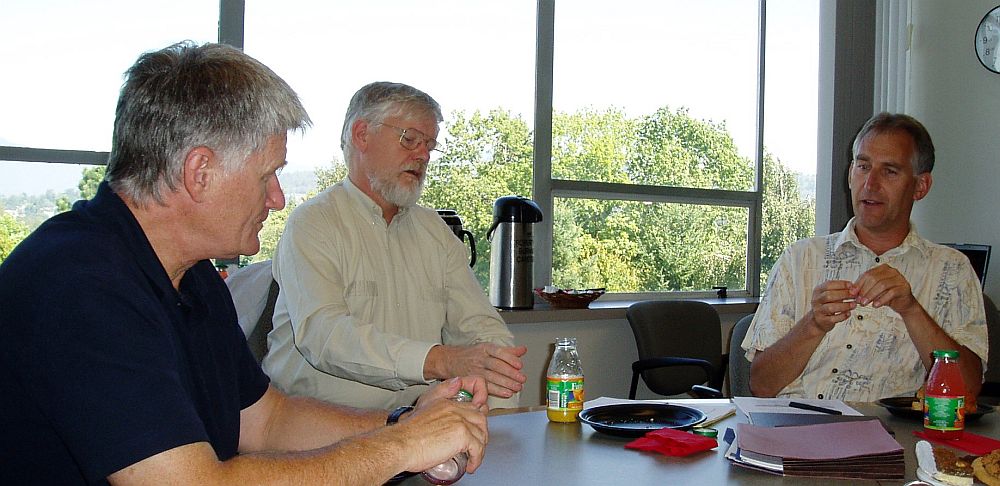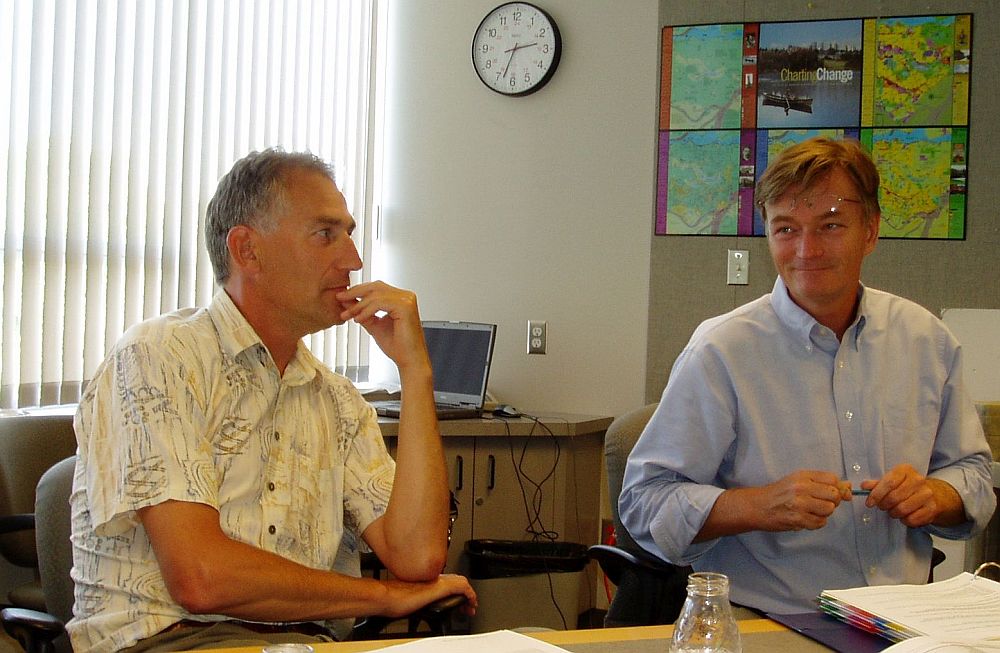WATER SUSTAINABILITY ACTION PLAN: Historical context for evolving from a community-of-interest on the waterbucket.ca website to implement and mainstream “Water-Centric Planning” in British Columbia
Note to Reader:
Water-Centric Planning is one of the six original elements of the Water Sustainability Action Plan for British Columbia. Released in February 2004, the Action Plan introduced a framework for building partnerships and demonstrating what can be achieved through a ‘top-down & bottom-up strategy’ that aligns efforts at the provincial, regional and local scales to respond and adapt to a changing world. Program delivery is by the Partnership for Water Sustainability in British Columbia.
The Action Plan is guided by the vision for Living Water Smart, British Columbia’s Water Plan, released in 2008, and the set of actions identified therein for building greener communities and adapting to a changing climate.
The article below provides historical context for the decisions by various government agencies to fund development of this community-of-interest. Originally written in 2005 when the community-of-interest was launched, the article has been amended over time in order to keep it fresh.
About Water-Centric Planning
 “Water-centric planning means planning with a view to water – whether for a single site or the entire province. At the core of water-centric planning is a water balance way-of-thinking and acting. The underpinning premise is that resource, land use and community design decisions will be made with an eye towards their potential impact on the watershed,” stated Kim Stephens, Executive Director of the Partnership for Water Sustainability in British Columbia.
“Water-centric planning means planning with a view to water – whether for a single site or the entire province. At the core of water-centric planning is a water balance way-of-thinking and acting. The underpinning premise is that resource, land use and community design decisions will be made with an eye towards their potential impact on the watershed,” stated Kim Stephens, Executive Director of the Partnership for Water Sustainability in British Columbia.
Integration of Missions, Mandates and Responsibilities
 “A water-centric approach puts water stewardship and sustainability front and centre on the agenda of comprehensive land use, development, or resource planning initiatives. Water-centric planning considers the amount of water available, the amount of water needed, innovative efficiency strategies, the quality of water leaving an area, how rain and snow water are managed, and the impact on the natural environment,” continued Erik Karlsen.
“A water-centric approach puts water stewardship and sustainability front and centre on the agenda of comprehensive land use, development, or resource planning initiatives. Water-centric planning considers the amount of water available, the amount of water needed, innovative efficiency strategies, the quality of water leaving an area, how rain and snow water are managed, and the impact on the natural environment,” continued Erik Karlsen.
In 2003, Erik Karlsen was a member of the team that created the Water Sustainability Action Plan for British Columbia in 2003. Erik Karlsen was Chair of the Agricultural Land Commission from 2005 through 2010.
“Implementation of water-centric strategies and solutions ultimately requires integration of missions, mandates and accountabilities of participating agencies,” concluded Erik Karlsen.
Action Plan Context
Over a three-year period (2004-2007), the branding image for the Water Sustainability Action Plan evolved to reflect changing circumstances. There were several developments in particular. The vision for a Water Sustainability Roundtable morphed into the Convening for Action initiative (2005); and the Watershed/Landscape-based Approach became Water-Centric Planning (2006). Coincidentally, Erik Karlsen was the key individual behind the redefining of both.
To Learn More:
To read the complete story about this evolution, click on WATER SUSTAINABILITY ACTION PLAN FOR BRITISH COLUMBIA:“After the Action Plan was released with the approval of the provincial government in February 2004, the branding graphic for the integrated scope of the partnership framework evolved from a jig-saw puzzle to a Venn diagram by 2007. This reflected the maturing of the Action Plan implementation program,” stated Ray Fung, Chair (2003-2008)

Why a Community-of-Interest (COI)
 “The notion of a web-based Community-of-Interest (COI) was developed to respond to the needs of organizational clusters which evolve to discuss and communicate ideas around a specific issue. The Waterbucket Website comprises a set of COIs that include each element of fhe Water Sustainability Action Plan for British Columbia. Over time it was envisioned that each COI would evolve into a community-of-practice (COP),” explained Mike Tanner, Waterbucket Chair.
“The notion of a web-based Community-of-Interest (COI) was developed to respond to the needs of organizational clusters which evolve to discuss and communicate ideas around a specific issue. The Waterbucket Website comprises a set of COIs that include each element of fhe Water Sustainability Action Plan for British Columbia. Over time it was envisioned that each COI would evolve into a community-of-practice (COP),” explained Mike Tanner, Waterbucket Chair.
Platform Design
“The original vision was that each COI would be a self-managing website that would provide easy access to a variety of information modules developed within the COI structure. This dynamic information source is developed on a collaborative, non-proprietary platform that allows emerging communities to leverage the investment of existing partners and use communication and web development resources effectively,” continued Mike Tanner.
“To enable users to customize their home pages by means of direct links, the Waterbucket website resides on a state-of-the-art RSS (Real Simple Syndication) platform. In other words, content can be provided by a live feed so that users will receive fresh information with each visit. This capability will enable users to take control of the flow of information, and add new layers of personalization and social sharing.”

Erik Karlsen, John Arber and Ted van der Gulik converse during a meeting of the British Columbia Water-Centric Working Group
Historical Context
In 2005, the Water-Centric Planning COI was developed so that it would serve as the communication vehicle for the British Columbia Water-Centric Working Group, under the umbrella of the original Water Sustainability Committee (2002 – 2010) of the BC Water & Waste Association. This provincial committee was the predecessor to the Partnership for Water Sustainability, incorporated as an autonomous non-profit entity in 2010.
Because the COI represented a coming together of a spectrum of perspectives, the original working group was co-chaired by local government and provincial representatives, namely: Robyn Wark (formerly of the City of Burnaby); and John Arber of the Water Stewardship Division of the Ministry of Environment.
COI Vision: a Water-Centric Planning Magazine
The Waterbucket Website is designed in a magazine style to appeal to specific target audiences, such that:
- The menus within each COI create the ‘storyline’ and supporting themes, so that users will keep coming back.
- The magazine part of the website is complemented by a database comprising web-accessible resources.
Originally, it was envisioned that over time the individual dropdowns could evolve into ‘second-level COIs’ as they build up a readership that is attracted by stories contributed on a continuing basis by a network of Content Experts. At the time of COI development, the individual work plans for provincial government staff included a line item to contribute stories for posting on the COI.

Zita Bothelo & Robyn Wark
Grant from National Water Supply Expansion Program enabled development of Water-Centric Planning Community-of-Interest to proceed
Acting in collaboration with the original Water Sustainability Committee (2002 – 2010) of the British Columbia Water & Waste Association, the Irrigation Industry Association of British Columbia (IIABC) received a grant from the National Water Supply Expansion Program for Canada and British Columbia (NWSEP) to develop a Community of Interest (COI) on Water-Centric Planning. COI development commenced in July 2005 when a provincial focus group was convened to review and brainstorm the COI themes and menu dropdowns.
 According to Robyn Wark, (former) City of Burnaby Ecosystem Planner and Co-Chair of the British Columbia Water-Centric Working Group, “Originally, this COI was to be called Watershed-Based Planning for consistency with the community planning element of the Water Sustainability Action Plan. However, the NWSEP grant combined with the support of the Province enabled us to broaden the scope of the COI to encompass a spectrum of perspectives, ranging from provincial watershed planning to local government community planning. This expanded scope is reflected in the table of contents, and is an ambitious undertaking. We are excited by the challenges that integration of perspectives involves!”
According to Robyn Wark, (former) City of Burnaby Ecosystem Planner and Co-Chair of the British Columbia Water-Centric Working Group, “Originally, this COI was to be called Watershed-Based Planning for consistency with the community planning element of the Water Sustainability Action Plan. However, the NWSEP grant combined with the support of the Province enabled us to broaden the scope of the COI to encompass a spectrum of perspectives, ranging from provincial watershed planning to local government community planning. This expanded scope is reflected in the table of contents, and is an ambitious undertaking. We are excited by the challenges that integration of perspectives involves!”
 “In addition to the NWSEP grant, the Ministry of Environment River Forecast Centre also provided funding”, added Ted van der Gulik, Vice-Chair of the (original) Water Sustainability Committee and Senior Engineer with the Ministry of Agriculture and Lands.
“In addition to the NWSEP grant, the Ministry of Environment River Forecast Centre also provided funding”, added Ted van der Gulik, Vice-Chair of the (original) Water Sustainability Committee and Senior Engineer with the Ministry of Agriculture and Lands.
“We also looked to other federal and provincial agencies to contribute to COI development by funding links to resources that those agencies maintain. The River Forecast Centre is a good example of what we had in mind. Through waterbucket.ca we can make the information on the Centre’s website more accessible and we can provide context that goes beyond simply providing a web link. In other words the objective is to add value.”
Greater Vancouver Regional District financial contribution accelerated development of Community-of-Interest
The Board of Directors of the Greater Vancouver Regional District (GVRD) awarded a grant from its Sustainability Enterprise Fund (SEF) to accelerate development of the Water-Centric Planning Community-of-Interest. SEF offers GVRD municipalities an opportunity to invest together in sustainability projects with region-wide benefits, and to share the risks and potential advantages of innovation.
An inter-municipal and inter-agency working group of the GVRD’s Technical Advisory Committee has developed an adaptable 10-step methodology for ‘planning with reference to watershed-based features’ so that resource, land use and community design decisions are made with an eye towards their potential impact on the watershed. This approach is being integrated with the revised Livable Region Strategic Plan.
 According to Ray Fung, (former) Chair of the original Water Sustainability Committee (WSC), “The WSC has undertaken to promote implementation of the watershed/landscape-based approach as an element of the Water Sustainability Action Plan. This will be achieved by developing awareness and understanding through web-based communication. The COI focus will be on tools that effectively consider ecological systems in community planning. The SEF Grant will enable creation of the COI structure complete with content placeholders. Content will then be created in successive phases of website development.”
According to Ray Fung, (former) Chair of the original Water Sustainability Committee (WSC), “The WSC has undertaken to promote implementation of the watershed/landscape-based approach as an element of the Water Sustainability Action Plan. This will be achieved by developing awareness and understanding through web-based communication. The COI focus will be on tools that effectively consider ecological systems in community planning. The SEF Grant will enable creation of the COI structure complete with content placeholders. Content will then be created in successive phases of website development.”
The original Water Bucket Website Partnership that was responsible for development of waterbucket.ca comprised representation from regional, provincial and federal agencies. “The Partnership gratefully acknowledges the financial support of the Sustainability Enterprise Fund, funded by the GVRD, towards completion of the project”, added Fung.

Ted van der Gulik and Doug Backhouse (original website developer)
Posted September 2005
Updated July 2009
Updated March 2013
Updated May 2020


